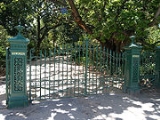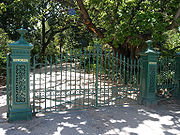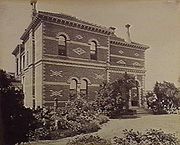
Rippon Lea Estate
Encyclopedia
Rippon Lea Estate is a historic property located in Elsternwick, Victoria
, Australia
. It is under the care of the National Trust of Australia
.


 It was built in 1868 for Sir Frederick Sargood, a wealthy Melbourne
It was built in 1868 for Sir Frederick Sargood, a wealthy Melbourne
businessman, politician and philanthropist. Frederick and his wife Marion purchased Crown Allotment 253 and either all, or part of Crown Allotment 260 in the Parish of Prahran, Elsternwick giving them a total area of 26 acres (105,218.4 m²). Located approximately 8 kilometres from the Melbourne central business district, he contracted a two-storey, 15 room house be built. An extensive pleasure garden was laid out around the house, together with glasshouses, vegetable gardens and orchards. The gardens were designed to be self-sufficient as regards water, and the large man-made lake on the property was designed to store stormwater run-off from the surrounding area. By the late 1870's Rippon Lea was a total of 45 acres (182,108.7 m²) with the 'kitchen garden' alone taking up 2 acres (8,093.7 m²)
The Sargood family lived at Rippon Lea until Frederick's death in 1903, and over the years extended the house on several occasions. The greatest structural changes occurred in 1897 when the house was extended to the north, and a tower was added. The style of the house has been described as "polychromatic romanesque" and the architect, Joseph Reed
, was said to have been inspired by the architecture of the Lombardy
region of northern Italy
. The house also contained many other innovations; it was one of the first in Australia to be lit by electricity, produced by its own generators, and Sargood employed a full-time electrician to maintain the system, and the fittings included an electrically powered bell system to communicate with the servants quarters and kitchens below stairs.
On Frederick's death in 1903, the property was sold to a consortium of real estate developers who had plans to demolish the house and subdivide the land. Elsternwick at this time was a new suburb on the outskirts of Melbourne; 35 years earlier when the Sargoods bought the land, it had been well outside the built-up area of Melbourne.
The house was empty for six years, while the developers sold off various parcels of land, particularly the orchards and paddocks. Before, however, the final carve-up of the estate could be undertaken, the leader of the consortium, Sir Thomas Bent
, died and the property was put on the market in 1910.
It was bought by Ben and Agnes Nathan, who owned the Maples chain of furniture stores in Melbourne. The Nathans lived there until Ben's death in 1935. The property then passed to their eldest daughter, Louisa, along with a legacy of £1 million.
Louisa (married name, Mrs Timothy Jones) was a leading figure in the Melbourne social set in the 1930s. She undertook extensive remodelling and renovation of the house to allow her to entertain on a lavish scale. The interior of the house was redecorated in a restrained classical 1930s style, drawing heavily on Hollywood film style of the 1930s and Syrie Maugham's "all white room" as influences. These renovations substantially altered most of the surviving Victorian
features of the house -- for example, the wallpaper in the entrance hall and corridors (originally embossed in gold) was over-painted in white, as were the marble columns around the main entrance.
The ornate iron-framed ballroom built by Frederick Sargood (which was converted from an earlier conservatory) was demolished to make way for a lavish "Hollywood style" swimming pool and ballroom and 14 acres (56,656 m²) of gardens were maintained. Mrs Jones also installed a new modern kitchen on the ground level and the original basement kitchen and service areas were closed up, which fortunately preserved many of the surviving 19th century features of this section of the house, including the cool room, the wine cellar and the large fuel stove.
In preparation for the 1956 Olympic Games
in Melbourne, a section of the property was compulsorily acquired by the Victorian government to house a new television studio complex for the Australian Broadcasting Corporation
(ABC). The Rippon Lea studio became the ABC's Melbourne studio and in later years were used as the production centre for many renowned ABC programs including Bellbird
, Countdown, The Big Gig
and The Late Show
.
Another section of the property was compulsorily acquired by the state government a few years later and Mrs Jones fought a long-running legal action against it. She eventually settled with the government, agreeing that, on her death the house and the land still in her possession would be bequeathed to the National Trust. With Mrs Jones death on July 27, 1972, the house and gardens were reunited with the disputed acquisition, saving the estate from the threat of sale and subdivision and allowing the public to enjoy the estate in perpetuity.
Of particular note in the grounds are the lake, the spectacular iron-framed fernery, the swimming pool and associated ballroom (1939, now leased to Peter Rowland Catering for social functions) and the stable complex (1868). The rooms of the basement kitchen complex are also of special interest, having been built in the 1880s and then abandoned in 1938 following the installation of a modern kitchen on the ground floor. Today they are a rare surviving Australian example of a 19th century kitchen suite; comprising kitchen, scullery, pantries, cool rooms, servants' hall and wine cellar.
Elsternwick, Victoria
Elsternwick is a suburb in Melbourne, Victoria, Australia, 9 km south-east from Melbourne's central business district. Its Local Government Area is the City of Glen Eira...
, Australia
Australia
Australia , officially the Commonwealth of Australia, is a country in the Southern Hemisphere comprising the mainland of the Australian continent, the island of Tasmania, and numerous smaller islands in the Indian and Pacific Oceans. It is the world's sixth-largest country by total area...
. It is under the care of the National Trust of Australia
National Trust of Australia
The Australian Council of National Trusts is the peak body for community-based, non-government organisations committed to promoting and conserving Australia's indigenous, natural and historic heritage....
.



Melbourne
Melbourne is the capital and most populous city in the state of Victoria, and the second most populous city in Australia. The Melbourne City Centre is the hub of the greater metropolitan area and the Census statistical division—of which "Melbourne" is the common name. As of June 2009, the greater...
businessman, politician and philanthropist. Frederick and his wife Marion purchased Crown Allotment 253 and either all, or part of Crown Allotment 260 in the Parish of Prahran, Elsternwick giving them a total area of 26 acres (105,218.4 m²). Located approximately 8 kilometres from the Melbourne central business district, he contracted a two-storey, 15 room house be built. An extensive pleasure garden was laid out around the house, together with glasshouses, vegetable gardens and orchards. The gardens were designed to be self-sufficient as regards water, and the large man-made lake on the property was designed to store stormwater run-off from the surrounding area. By the late 1870's Rippon Lea was a total of 45 acres (182,108.7 m²) with the 'kitchen garden' alone taking up 2 acres (8,093.7 m²)
The Sargood family lived at Rippon Lea until Frederick's death in 1903, and over the years extended the house on several occasions. The greatest structural changes occurred in 1897 when the house was extended to the north, and a tower was added. The style of the house has been described as "polychromatic romanesque" and the architect, Joseph Reed
Joseph Reed (architect)
Joseph Reed , a Cornishman by birth, was probably the most influential Victorian era architect in Melbourne, Australia. He established a practice, Reed and Barnes in Melbourne in 1852. The practice now known as Bates Smart is one of the oldest continually operating in the world.Reed's buildings...
, was said to have been inspired by the architecture of the Lombardy
Lombardy
Lombardy is one of the 20 regions of Italy. The capital is Milan. One-sixth of Italy's population lives in Lombardy and about one fifth of Italy's GDP is produced in this region, making it the most populous and richest region in the country and one of the richest in the whole of Europe...
region of northern Italy
Italy
Italy , officially the Italian Republic languages]] under the European Charter for Regional or Minority Languages. In each of these, Italy's official name is as follows:;;;;;;;;), is a unitary parliamentary republic in South-Central Europe. To the north it borders France, Switzerland, Austria and...
. The house also contained many other innovations; it was one of the first in Australia to be lit by electricity, produced by its own generators, and Sargood employed a full-time electrician to maintain the system, and the fittings included an electrically powered bell system to communicate with the servants quarters and kitchens below stairs.
On Frederick's death in 1903, the property was sold to a consortium of real estate developers who had plans to demolish the house and subdivide the land. Elsternwick at this time was a new suburb on the outskirts of Melbourne; 35 years earlier when the Sargoods bought the land, it had been well outside the built-up area of Melbourne.
The house was empty for six years, while the developers sold off various parcels of land, particularly the orchards and paddocks. Before, however, the final carve-up of the estate could be undertaken, the leader of the consortium, Sir Thomas Bent
Thomas Bent
Sir Thomas Bent KCMG , Australian politician, was the 22nd Premier of Victoria. He was one of the most colourful and corrupt politicians in Victorian history....
, died and the property was put on the market in 1910.
It was bought by Ben and Agnes Nathan, who owned the Maples chain of furniture stores in Melbourne. The Nathans lived there until Ben's death in 1935. The property then passed to their eldest daughter, Louisa, along with a legacy of £1 million.
Louisa (married name, Mrs Timothy Jones) was a leading figure in the Melbourne social set in the 1930s. She undertook extensive remodelling and renovation of the house to allow her to entertain on a lavish scale. The interior of the house was redecorated in a restrained classical 1930s style, drawing heavily on Hollywood film style of the 1930s and Syrie Maugham's "all white room" as influences. These renovations substantially altered most of the surviving Victorian
Victorian architecture
The term Victorian architecture refers collectively to several architectural styles employed predominantly during the middle and late 19th century. The period that it indicates may slightly overlap the actual reign, 20 June 1837 – 22 January 1901, of Queen Victoria. This represents the British and...
features of the house -- for example, the wallpaper in the entrance hall and corridors (originally embossed in gold) was over-painted in white, as were the marble columns around the main entrance.
The ornate iron-framed ballroom built by Frederick Sargood (which was converted from an earlier conservatory) was demolished to make way for a lavish "Hollywood style" swimming pool and ballroom and 14 acres (56,656 m²) of gardens were maintained. Mrs Jones also installed a new modern kitchen on the ground level and the original basement kitchen and service areas were closed up, which fortunately preserved many of the surviving 19th century features of this section of the house, including the cool room, the wine cellar and the large fuel stove.
In preparation for the 1956 Olympic Games
1956 Summer Olympics
The 1956 Melbourne Summer Olympics, officially known as the Games of the XVI Olympiad, were an international multi-sport event which was held in Melbourne, Australia, in 1956, with the exception of the equestrian events, which could not be held in Australia due to quarantine regulations...
in Melbourne, a section of the property was compulsorily acquired by the Victorian government to house a new television studio complex for the Australian Broadcasting Corporation
Australian Broadcasting Corporation
The Australian Broadcasting Corporation, commonly referred to as "the ABC" , is Australia's national public broadcaster...
(ABC). The Rippon Lea studio became the ABC's Melbourne studio and in later years were used as the production centre for many renowned ABC programs including Bellbird
Bellbird (TV series)
Bellbird was an Australian soap opera set in a small Victorian rural township. The series was produced by the Australian Broadcasting Corporation at its Ripponlea TV studios in Elsternwick, Melbourne, Victoria. The series was produced between 28 August 1967 and December 1977...
, Countdown, The Big Gig
The Big Gig
The Big Gig was a popular Australian television comedy series based on the British TV series Saturday Live. It was produced and broadcast by the ABC in the late 1980s and early 1990s and was produced and directed by Ted Robinson, who started his career as the director of the second series of the...
and The Late Show
The Late Show (Australian TV series)
The Late Show was a popular Australian comedy show, which ran for two seasons on ABC from 18 July 1992 to 30 October 1993.-Cast:The Late Show has its roots in the 1980s comedy group, The D-Generation...
.
Another section of the property was compulsorily acquired by the state government a few years later and Mrs Jones fought a long-running legal action against it. She eventually settled with the government, agreeing that, on her death the house and the land still in her possession would be bequeathed to the National Trust. With Mrs Jones death on July 27, 1972, the house and gardens were reunited with the disputed acquisition, saving the estate from the threat of sale and subdivision and allowing the public to enjoy the estate in perpetuity.
Of particular note in the grounds are the lake, the spectacular iron-framed fernery, the swimming pool and associated ballroom (1939, now leased to Peter Rowland Catering for social functions) and the stable complex (1868). The rooms of the basement kitchen complex are also of special interest, having been built in the 1880s and then abandoned in 1938 following the installation of a modern kitchen on the ground floor. Today they are a rare surviving Australian example of a 19th century kitchen suite; comprising kitchen, scullery, pantries, cool rooms, servants' hall and wine cellar.

